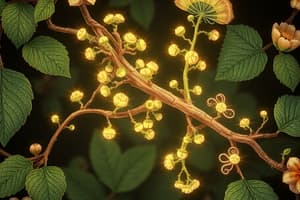Podcast
Questions and Answers
Match the following components of xylem with their characteristics:
Match the following components of xylem with their characteristics:
Vessels = Water movement through ends and pits Tracheids = Water movement through pits only
Match the following components of phloem with their functions:
Match the following components of phloem with their functions:
Sieve Tube = Transports organic substances Companion Cells = Provides energy to sieve tubes Sieve Plate = Allows phloem sap to move between cells Plasmodesmata = Facilitates exchange of substances
Match the following terms with their definitions:
Match the following terms with their definitions:
Sources = Net producer of sugar Sinks = Receives sugar Loading = Sugar transferred to phloem sap Translocation = Movement of phloem sap to sinks
Match the following solutes in phloem sap with their roles:
Match the following solutes in phloem sap with their roles:
Match the following uses of sugar in sinks with their purposes:
Match the following uses of sugar in sinks with their purposes:
Match the following plant structures with their primary functions:
Match the following plant structures with their primary functions:
Match the following plant types with their characteristics:
Match the following plant types with their characteristics:
Match the following adaptations of xylem with their descriptions:
Match the following adaptations of xylem with their descriptions:
Match the following parts of the plant with their distributions:
Match the following parts of the plant with their distributions:
Match the consequences of lacking lignin deposition with their effects:
Match the consequences of lacking lignin deposition with their effects:
Flashcards
What is xylem?
What is xylem?
Xylem is a specialized tissue in plants that transports water and dissolved minerals from the roots to the leaves.
What is phloem?
What is phloem?
Phloem transports sugars produced during photosynthesis from the leaves to other parts of the plant.
What is lignin?
What is lignin?
Lignin is a strong, waterproof polymer that adds rigidity and structural support to xylem cells.
Why is lignin important for xylem function?
Why is lignin important for xylem function?
Signup and view all the flashcards
What are pits in xylem?
What are pits in xylem?
Signup and view all the flashcards
Sieve tube
Sieve tube
Signup and view all the flashcards
Sieve plate
Sieve plate
Signup and view all the flashcards
Companion cell
Companion cell
Signup and view all the flashcards
Source
Source
Signup and view all the flashcards
Sink
Sink
Signup and view all the flashcards
Study Notes
Plant Transport Systems
- Flowering plants are divided into two groups: Monocots and Dicots.
- Monocot leaves have parallel veins, while Dicot leaves have branched veins.
- Examples of Monocots include corn and herbs.
- Examples of Dicots include broad-leaved plants like vegetables and fruits.
- Xylem is responsible for transporting water and minerals from roots to leaves.
- Phloem transports food from leaves to other plant parts.
- Xylem and phloem are arranged in vascular bundles inside the endodermis.
Distribution of Vascular Bundles
- In roots, the vascular system is composed of one vascular bundle in the center, with xylem in a star-like pattern.
- In stems, the vascular bundles form a ring around the center.
- Xylem is positioned towards the center to reduce water evaporation.
- In leaves, the vascular bundles are located next to the upper and lower leaf surfaces.
Water Movement From Soil to Roots
- Water moves from the soil to the root hair cells through osmosis.
- Water moves from an area of high water potential (soil) to an area of low water potential (root hair cells).
Xylem Structure and Function
- Xylem cells are elongated and joined end to end to form hollow tubes.
- Xylem walls are composed of lignin and cellulose, which makes them strong and waterproof.
- Lignin prevents the collapse of xylem vessels under water pressure.
- Xylem is responsible for transporting water and minerals from roots to the rest of the plant.
- Xylem is strong and essential for structural support.
Phloem Structure and Function
- Phloem tubes are made of sieve tube elements, which are stacked end to end.
- Sieve plates have holes to allow the movement of phloem sap.
- Companion cells support sieve tubes' metabolic activities, providing energy and proteins.
- Phloem is responsible for transporting food (sugars) throughout the plant.
Translocation (Phloem Transport)
- Loading occurs when sugars move from sources (e.g., leaves) into phloem sieve tubes. This process is usually active (requires energy).
- Translocation is the movement of sugars through the phloem. The process is dependent on hydrostatic pressure gradients.
- Unloading occurs when sugars move from phloem sieve tubes to sinks (e.g., roots, fruits). This is usually an active process.
- Companion cells play a key role in loading and unloading sugars.
- The pressure flow hypothesis explains the movement of sugars in phloem. It involves a difference in hydrostatic pressure between source and sink.
Difference Between Xylem and Phloem
- Xylem: dead tissue, unidirectional transport, passive transport, transports water and minerals.
- Phloem: living tissue, bidirectional transport, active transport, transports sugars.
Studying That Suits You
Use AI to generate personalized quizzes and flashcards to suit your learning preferences.




